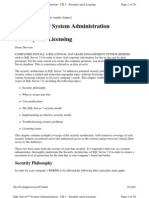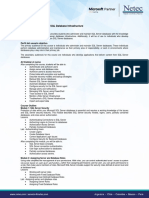Best Practices On SQL Server Security
Uploaded by
oluyinkaa14Best Practices On SQL Server Security
Uploaded by
oluyinkaa14Best practices on SQL Server Security
Best practices for SQL Server security are essential for protecting sensitive
data, maintaining data integrity, and ensuring regulatory compliance. Below
are some key practices to enhance SQL Server security:
1. Use Strong Authentication: Utilize strong authentication methods such as
Windows Authentication or Azure Active Directory Authentication rather
than SQL Server Authentication whenever possible. This reduces the risk of
unauthorized access due to weak passwords.
2. Implement Principle of Least Privilege (PoLP): Assign permissions to users
and roles based on the principle of least privilege. Limit access to only the
necessary resources and operations required for users to perform their job
functions.
3. Regularly Update and Patch SQL Server: Keep SQL Server up-to-date with
the latest security patches and updates released by Microsoft. This helps to
mitigate vulnerabilities that could be exploited by attackers.
4. Encrypt Data: Use Transparent Data Encryption (TDE) to encrypt data at rest,
and implement SSL/TLS encryption for data transmitted over the network.
Encryption helps protect data in case of unauthorized access or data
breaches.
5. Enable Auditing and Monitoring: Enable SQL Server Audit to track and log
events such as logins, access to sensitive data, and configuration changes.
Implement monitoring solutions to detect suspicious activities and potential
security threats.
6. Secure Network Access: Restrict network access to SQL Server by
configuring firewalls and using network security protocols such as IPsec.
Limit exposure to external networks by placing SQL Server behind a firewall
and using private network segments.
7. Secure SQL Server Configuration: Follow security best practices for
configuring SQL Server settings. Disable unnecessary features and services,
change default ports, and apply appropriate security configurations such as
enabling data encryption and enforcing password policies.
8. Regularly Backup and Test Backups: Implement regular database backups
and store them securely, preferably off-site. Test backup and restore
procedures to ensure data can be recovered in case of data loss or
corruption due to security incidents or hardware failures.
9. Implement Role-Based Access Control (RBAC): Define roles and
permissions based on job responsibilities and business requirements. Use
RBAC to enforce access controls and ensure that users have the appropriate
level of access to data and resources.
10. Regular Security Assessments and Penetration Testing: Conduct regular
security assessments and penetration testing to identify vulnerabilities and
weaknesses in SQL Server security controls. Address any findings promptly to
improve the overall security posture.
11. Employee Training and Awareness: Educate database administrators,
developers, and other personnel about SQL Server security best practices,
common security threats, and how to recognize and respond to security
incidents effectively.
12. Compliance with Regulations: Ensure compliance with relevant data
protection regulations such as GDPR, HIPAA, or PCI DSS. Implement security
measures and controls to protect sensitive data and maintain compliance
with regulatory requirements.
By implementing these best practices, organizations can enhance the security
of their SQL Server environments and mitigate the risk of data breaches,
unauthorized access, and other security threats. Regularly reviewing and
updating security measures is crucial to adapting to evolving security threats
and maintaining a strong defense against potential attacks.
You might also like
- SQL Server Security Best Practices - Database Management - Blogs - Quest CommunityNo ratings yetSQL Server Security Best Practices - Database Management - Blogs - Quest Community9 pages
- SQL Server Security Best Practices 0932719630No ratings yetSQL Server Security Best Practices 09327196307 pages
- Best Practices For Becoming An Exceptional SQL Server DBANo ratings yetBest Practices For Becoming An Exceptional SQL Server DBA14 pages
- 32-Inference - Multilevel Databases-01-10-2024No ratings yet32-Inference - Multilevel Databases-01-10-20242 pages
- Top 10 Database Security Best PracticesNo ratings yetTop 10 Database Security Best Practices10 pages
- Microsoft Azure Security Technologies Practice Tests AZ-500From EverandMicrosoft Azure Security Technologies Practice Tests AZ-500No ratings yet
- Chapter 6 Database Security and AuthorizationNo ratings yetChapter 6 Database Security and Authorization6 pages
- Oracle Quick Guides: Part 4 - Oracle Administration: Security and PrivilegeFrom EverandOracle Quick Guides: Part 4 - Oracle Administration: Security and PrivilegeNo ratings yet
- Chapter 2 Reviewer - The Need For Information SecurityNo ratings yetChapter 2 Reviewer - The Need For Information Security3 pages
- SQL Server 2012 Security Best Practice Whitepaper Apr2012No ratings yetSQL Server 2012 Security Best Practice Whitepaper Apr201238 pages
- 20764C - Administering A SQL Database Infrastructure: Acerca de Este CursoNo ratings yet20764C - Administering A SQL Database Infrastructure: Acerca de Este Curso6 pages
- Best Practices: IBM Data Server SecurityNo ratings yetBest Practices: IBM Data Server Security38 pages
- Sql : The Ultimate Beginner to Advanced Guide To Master SQL Quickly with Step-by-Step Practical ExamplesFrom EverandSql : The Ultimate Beginner to Advanced Guide To Master SQL Quickly with Step-by-Step Practical ExamplesNo ratings yet
- Java Secure Coding Techniques: Strategies for Preventing VulnerabilitiesFrom EverandJava Secure Coding Techniques: Strategies for Preventing VulnerabilitiesNo ratings yet
- Kubernetes Security Ebook Tips Tricks Best Practices PDFNo ratings yetKubernetes Security Ebook Tips Tricks Best Practices PDF20 pages
- Describe Security and Compliance Concepts: 1. Describe The Shared Responsibility ModelNo ratings yetDescribe Security and Compliance Concepts: 1. Describe The Shared Responsibility Model71 pages
- Certified Kubernetes Application Developer (CKAD) Crash Course in 3 Days - O'Reilly Live EventsNo ratings yetCertified Kubernetes Application Developer (CKAD) Crash Course in 3 Days - O'Reilly Live Events8 pages
- XACML and Role-Based Access Control: Jason CramptonNo ratings yetXACML and Role-Based Access Control: Jason Crampton32 pages
- Context-Based Access Control for Zero Trust 20250114No ratings yetContext-Based Access Control for Zero Trust 2025011424 pages
- Microsoft 365 Certified Security Administrator Associate Skills MeasuredNo ratings yetMicrosoft 365 Certified Security Administrator Associate Skills Measured5 pages
- CCURE 9000 v29 and iSTAR Hardening Guide v1100% (1)CCURE 9000 v29 and iSTAR Hardening Guide v127 pages
- Oracle® Applications: System Administrator's Guide - Security Release 11iNo ratings yetOracle® Applications: System Administrator's Guide - Security Release 11i146 pages
- Ebs Approvals List Creation Limits and RulesNo ratings yetEbs Approvals List Creation Limits and Rules85 pages
- Role Based Access Control Second Edition David F. Ferraiolo - Get instant access to the full ebook with detailed contentNo ratings yetRole Based Access Control Second Edition David F. Ferraiolo - Get instant access to the full ebook with detailed content52 pages
- API - Practical Deployment of Cisco Identity Services Engine (ISE)No ratings yetAPI - Practical Deployment of Cisco Identity Services Engine (ISE)3 pages
- 3662 - Plan and Manage Role Based Access Control RBACNo ratings yet3662 - Plan and Manage Role Based Access Control RBAC5 pages
- Blockchain-Based Chain of Custody Evidence Management System For Digital Forensic InvestigationsNo ratings yetBlockchain-Based Chain of Custody Evidence Management System For Digital Forensic Investigations6 pages
- Exam AZ-305 Title Designing Microsoft Azure Infrastructure Solutions (Beta) 1.0 Product Type 59 Q&A With ExplanationsNo ratings yetExam AZ-305 Title Designing Microsoft Azure Infrastructure Solutions (Beta) 1.0 Product Type 59 Q&A With Explanations64 pages
- Module4 Cloudcomputing Final 17308673843060No ratings yetModule4 Cloudcomputing Final 173086738430609 pages

























































































